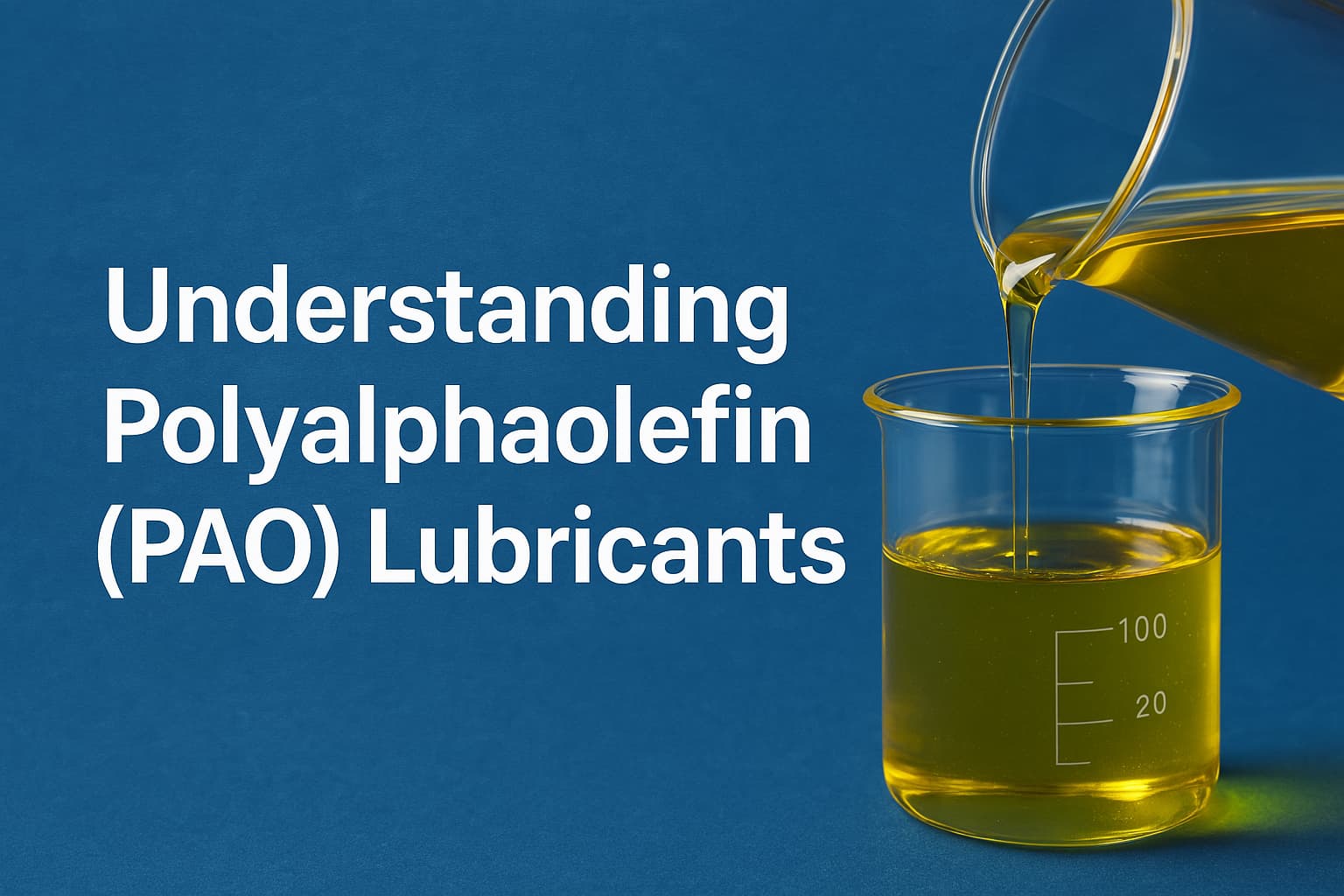Unlocking the Benefits of Polyalphaolefin (PAO) Lubricants
Choosing a lubricant for demanding applications requires careful consideration of polyalphaolefins (PAOs). These advanced synthetic hydrocarbons consistently outperform conventional oils in key performance metrics. PAOs maintain viscosity even in extreme temperatures, resist oxidation effectively, and significantly extend equipment lifespan compared to mineral oils.
What factors contribute to the effectiveness of these specialized molecules? Are there any potential downsides?
Key Attributes of PAOs
- Viscosity Stability: PAOs excel in maintaining viscosity, ensuring optimal lubrication in both high and low-temperature conditions.
- Oxidation Resistance: These lubricants resist oxidation, reducing the risk of breakdown and enhancing performance longevity.
- Extended Equipment Life: By minimizing wear and tear, PAOs help prolong the life of machinery and reduce maintenance costs.
Potential Limitations of PAOs
Despite their numerous benefits, PAOs may have some limitations:
- Cost: Advanced formulations can be more expensive than traditional mineral oils.
- Compatibility: PAOs might not be compatible with all existing lubricants, requiring careful evaluation before switching.
In conclusion, armor lubricants featuring PAOs present clear advantages for high-performance applications. Their superior attributes deliver reliability and efficiency, making them an excellent choice for businesses seeking to enhance operational performance.
What Are Polyalphaolefins? Composition and Structure
Understanding Polyalphaolefins: Composition and Structure
In the realm of synthetic lubricants, Polyalphaolefins (PAOs) stand out for their high performance. These synthetic hydrocarbons possess a precisely controlled molecular structure, created through polymerization, hydrogenation, and distillation of linear alpha-olefins.
Conventional mineral oils often contain unwanted elements. PAOs eliminate ring structures, double bonds, sulfur, nitrogen components, and waxy hydrocarbons. This absence results in a non-polar base oil that offers superior viscosity stability and oxidation resistance.
Key advantages of PAOs include:
- An impressive viscosity index of approximately 130
- Consistent performance across extreme temperature ranges
- Excellent low-temperature flow properties, making them ideal for cold climates
- Reduced volatility and lower hydrocarbon emissions compared to traditional oils
These features make PAOs particularly suited for demanding applications, ensuring optimal performance in challenging conditions.
Key Performance Characteristics of PAO Lubricants
Key Performance Characteristics of PAO Lubricants
Examining the composition of PAOs reveals the key factors that make these lubricants outstanding in practical applications.
PAO base oils excel due to their high viscosity index of approximately 130, providing consistent performance across temperature fluctuations.
You’ll appreciate their excellent low-temperature fluidity, which maintains vital protection even in extreme cold conditions that challenge many other lubricants.
The non-polar nature of PAOs enhances their versatility. They easily blend with mineral oils, seals, and paints, simplifying system transformations and maintenance.
The absence of waxy hydrocarbons and impurities supports superior thermal stability, resulting in reduced volatility at high temperatures.
Outstanding oxidation resistance significantly extends the service life of PAO lubricants.
With these properties combined, PAO lubricants offer reliable, long-lasting performance, making them ideal for demanding applications.
Key Benefits of PAO Lubricants:
- High Viscosity Index: Guarantees consistent operation across temperature changes.
- Excellent Low-Temperature Fluidity: Ensures protection in extreme cold conditions.
- Compatibility: Works seamlessly with mineral oils, seals, and paints.
- Thermal Stability: Offers reduced volatility at high temperatures.
- Oxidation Resistance: Extends service life and reliability.
Choosing PAO lubricants contributes to the efficiency and longevity of your equipment, making them a smart investment for various industries.
Temperature Stability: PAO Advantages in Extreme Conditions
Exceptional Temperature Stability of PAO Lubricants in Extreme Conditions****
PAO lubricants excel in extreme environments where conventional oils struggle. Operating equipment in temperatures exceeding 100°C showcases how polyalphaolefin maintains integrity without significant degradation.
PAO boasts an impressive viscosity index of approximately 130. This property guarantees consistent performance across diverse temperature ranges. Even in frigid conditions, PAO remains fluid, which helps prevent costly equipment failures and downtime.
Key advantages of PAO lubricants include:
- Low volatility: Reduces oil consumption in high-temperature applications.
- Superior oxidation resistance: Extends service intervals and enhances lubricating life.
The combination of thermal stability and temperature versatility empowers better control over maintenance schedules and operational reliability. PAO lubricants provide predictable performance in both desert heat and arctic cold.
With Armor Lubricants, you can rely on consistent and dependable lubrication. Experience the benefits that PAO lubricants bring to your operations, whether facing extreme heat or frigid temperatures.
Comparing PAOs to Mineral and Other Synthetic Lubricants
Advantages of PAO Lubricants Over Mineral Options****
PAO lubricants excel in the industrial oils market due to several key benefits. When comparing PAO oil bases to mineral options, notable performance differences become evident.
- Chemically Pure Structure: PAOs lack the sulfur and waxy hydrocarbons present in mineral oils. This purity leads to reduced emissions and enhanced oxidative stability.
- High Viscosity Index: With a viscosity index around 130, PAOs maintain consistent performance across extreme temperature ranges.
- Seal Compatibility: PAOs may require blending with polar esters to improve seal compatibility in systems that previously used mineral oils.
- Performance in Low-Temperature Conditions: PAOs offer excellent low-temperature fluidity, although they mightn’t perform as well as PAGs under extremely high-pressure situations.
Unlike PAO options, mineral oils deliver thermal stability protection across wide operating temperatures while remaining an economical choice for many applications.
Armor Lubricants stands out with its commitment to developing superior PAO formulations that cater to a variety of applications.
These formula enhancements deliver optimal protection, efficiency, and reliability. By choosing Armor Lubricants, you invest in a solution that meets high-performance standards while promoting sustainability in your operations.
Common Applications and Industries Using PAO Technology
Exploring the Impact of PAO Technology Across Various Industries
PAO oil outshines mineral oils in many applications, making a significant impact across various sectors.
In the automotive industry, PAO technology plays a crucial role. Its exceptional viscosity index and low-temperature flow characteristics guarantee reliable vehicle performance in all climates.
In industrial settings, PAOs power hydraulic systems, gears, and bearings, ensuring maximum equipment reliability even under extreme conditions.
PAO oil also excels in grease formulations, offering consistent performance across wide temperature ranges. This adaptability allows for a seamless transition to synthetic lubricants without the need for system overhauls.
In electrical applications, PAOs protect transformers and cables from thermal degradation while maintaining peak efficiency, showcasing their versatility and reliability.
For optimal engine efficiency, PAO-based fully synthetic motor oils deliver superior lubrication that significantly reduces friction and wear in extreme operating conditions.
Key Applications of PAO Technology:
- Automotive: Ensures reliable vehicle performance in various climates.
- Industrial: Powers hydraulic systems and maximizes gear reliability.
- Grease Formulations: Delivers consistent performance across temperature ranges.
- Electrical Applications: Protects transformers and cables from overheating.
Limitations and Challenges of Polyalphaolefin Lubricants
Limitations of Polyalphaolefin Lubricants
PAO lubricants deliver impressive performance characteristics, yet face significant limitations that hinder their universal application.
Evaluate the following drawbacks when selecting lubricants for your specific needs:
- Seal Compatibility: PAOs cause seal shrinkage, leading to compatibility issues with certain elastomers in lubrication systems.
- Additive Dissolution: These lubricants struggle to dissolve common oil additives, which may limit performance enhancements in your formulations.
- Temperature and Pressure Limits: PAO effectiveness declines significantly in high-temperature and high-pressure applications, often underperforming compared to PAGs.
- Fire Resistance and Biodegradability: Their low fire resistance and poor biodegradability raise safety and environmental concerns.
When implementing PAO lubricants in your operations, you may need to consider supplementary solutions or alternative formulations.
Addressing these limitations is crucial to maintaining optimal system performance while meeting safety and environmental requirements.
Blending PAOS With Other Base Oils for Enhanced Performance
Blending PAOs with Organic Ester Base Oils for Enhanced Performance****
Blending PAOs with organic ester synthetic base oils significantly improves seal compatibility and additive solubility.
These formulations allow customization of viscosity profiles for specific operational requirements across various applications.
The resulting lubricants effectively prevent seal shrinkage and provide enhanced biodegradability and fire resistance compared to using PAOs alone.
Key Benefits of Blending PAOs with Organic Esters:
- Improved Seal Compatibility: Achieve better performance in sealing applications.
- Enhanced Additive Solubility: Supports a wider range of additive packages.
- Customizable Viscosity Profiles: Tailor viscosity to suit specific operating conditions.
- Increased Biodegradability: Contribute to environmentally friendly practices.
- Fire Resistance: Offer greater safety in high-temperature applications.
Ester Compatibility Benefits
Enhancing PAO Lubricant Performance with Organic Esters****
Blending poly alpha olefin (PAO) lubricants with organic esters offers significant advantages that elevate your formulations. These strategic combinations lead to markedly improved performance characteristics deserving your attention.
Key advantages include:
- Improved seal and elastomer compatibility: PAOs naturally cause shrinkage, but adding esters counteracts this issue.
- Enhanced additive solubility: This allows for a broader incorporation of performance-boosting chemicals into your formulations.
- Better low-temperature flow properties: Achieve a more balanced viscosity index across operational temperatures, improving overall efficiency.
- Extended application versatility: These blends offer capabilities that pure PAOs can’t provide on their own.
Blend choice gives you greater control over lubricant performance in demanding environments.
By harnessing the strengths of esters alongside PAOs, you effectively mitigate inherent limitations while maintaining the core advantages of premium poly alpha olefin lubricants.
For Armor Lubricants, this means delivering products that meet the rigorous demands of various applications.
Viscosity Profile Optimization
Optimize Viscosity Profiles with PAO Blends****
Strategic blending of PAOs with complementary base oils creates lubricant formulations that deliver enhanced viscosity profiles, outperforming single-component options.
Combining PAO fluid with organic ester synthetics improves seal compatibility while maintaining excellent viscosity indices around 130.
Blend Types and Key Benefits:
- PAO + Ester: Improved additive solubility for high-temperature machinery.
- PAO + Biodegradable: Enhanced environmental profile suitable for outdoor equipment.
- PAO + Fire-resistant: Increased safety margin in industrial systems.
- PAO + Elastomer-friendly: Better seal longevity in precision components.
- Custom PAO Blends: Tailored viscosity properties for extreme conditions.
These optimized blends effectively address the inherent limitations of PAOs while leveraging their controlled structure.
You gain protection in high-pressure scenarios without compromising performance. This offers complete control over your lubrication strategy across varying temperature ranges.
By prioritizing these advanced formulations, Armor Lubricants empowers you to achieve superior results in your lubrication applications.
Embrace the benefits of customized blends and enhance your operational efficiency today.
Frequently Asked Questions
What Are the Disadvantages of Pao Oil?
Disadvantages of PAO Oil
PAO oils present several challenges that can limit the performance and safety of your lubrication system.
Key disadvantages include:
- Seal Shrinkage: PAO oils can cause seals to shrink, leading to potential leaks and compromised equipment integrity.
- Poor Additive Solubility: These oils struggle to dissolve additives effectively, resulting in diminished lubrication properties.
- Extreme Condition Difficulty: In harsh environments, PAO oils do not perform well, which may lead to equipment failure.
- Flammability Risk: Lacking sufficient fire resistance, PAO oils can pose safety hazards in high-temperature applications.
- Non-Biodegradable: Their inability to break down naturally raises environmental concerns.
What Does PAO Mean in Lubricant?
Understanding PAO in Lubricants
In lubricants, PAO stands for Polyalphaolefin. This synthetic base oil excels in high-performance applications that require remarkable temperature stability and extended fluid life.
Key characteristics of PAO include:
- Excellent temperature stability: Maintains viscosity across a wide range of temperatures.
- Longer fluid life: Reduces the need for frequent oil changes.
- Enhanced lubrication: Offers reliable performance even under extreme conditions.
Armor Lubricants features PAO in several products, showcasing superior performance that meets the demands of various industries. Whether you need lubrication for machinery or automotive applications, PAO formulations deliver optimal results.
Consider the benefits of using lubricants with PAO:
- Improved system efficiency
- Reduced wear and tear
- Lower operational costs
Investing in PAO-based lubricants provides long-term benefits, enhancing the reliability and longevity of your equipment.
What Is the Difference Between PAG and PAO Oil?
Differences Between PAG and PAO Oil
PAGs and PAOs represent two distinct types of synthetic oils, each with unique characteristics.
PAOs are non-polar, exhibiting low biodegradability and exhibiting better compatibility with mineral oil. In contrast, PAGs possess polar characteristics, offering superior fire resistance and enhanced biodegradability. However, PAGs tend to be less compatible with conventional systems.
Key Differences
- Chemical Structure:
- PAOs: Non-polar, lower biodegradability.
- PAGs: Polar, superior fire resistance, higher biodegradability.
- Compatibility:
- PAOs: Better compatibility with mineral oils.
- PAGs: Less favorable in conventional systems, require specialized formulations.
PAGs offer excellent fire resistance, making them ideal for high-temperature applications. Their biodegradability makes them a more environmentally friendly option.
PAOs shine in terms of stability and performance across a wide range of temperatures. Their compatibility with mineral oils allows for easier blending in various applications.
Understanding these differences helps in selecting the right oil for specific needs, ensuring optimal performance and sustainability. For those looking for reliable options, Armor Lubricants provides high-quality solutions tailored to various applications.
Is Pao Oil Better?
Is PAO Oil the Best Choice for You?
PAO oil offers distinct advantages, but whether it suits your needs depends on your specific requirements.
- Temperature stability
- Extended lifespan
- Compatibility with mineral oils
However, some considerations include potential seal shrinkage and limitations in additive performance.
Evaluate how these factors align with your application to determine if PAO oil is the right fit.
Conclusion
Polyalphaolefins (PAOs) possess a unique molecular structure that contributes to their exceptional performance in various applications. Their remarkable temperature stability and oxidation resistance enable them to outperform conventional mineral oils in demanding environments.
While PAOs face challenges in terms of seal compatibility and biodegradability, blending them with complementary base oils can effectively address these limitations. In extreme conditions, few lubricants can rival their capabilities.
Key Benefits of PAOs:
- Temperature Stability: Retains performance across a wide temperature range.
- Oxidation Resistance: Resists breakdown over time, extending lubricant life.
- Versatile Applications: Suited for high-performance machinery and automotive applications.
Take advantage of PAOs’ superior features to optimize your lubricant selection, especially in critical systems where reliability is paramount. With Armor Lubricants’ advanced formulations, you can achieve enhanced performance and protection for your equipment.



